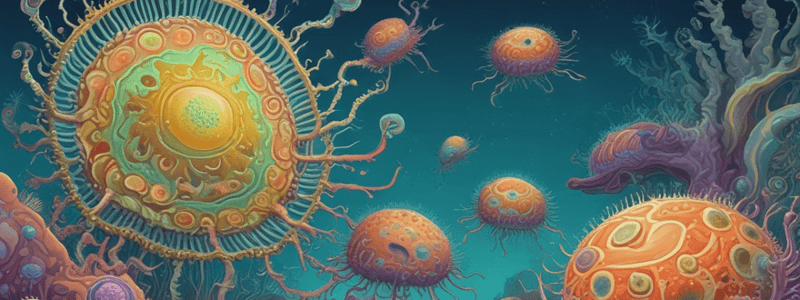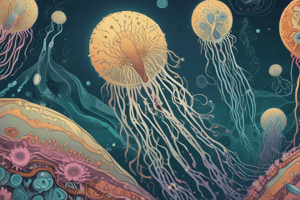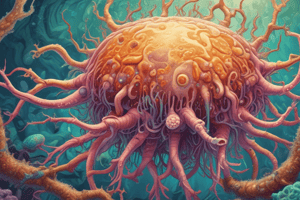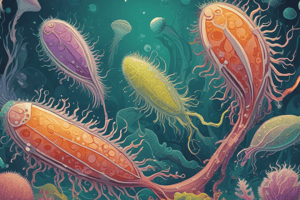Podcast
Questions and Answers
What is the characteristic feature of Euglenozoa?
What is the characteristic feature of Euglenozoa?
- Cellulose plates reinforcing the cell
- Spiral or crystalline rod inside their flagella (correct)
- Single mitochondrion with an organized mass of DNA
- Membrane-bounded sacs under the plasma membrane
Dinoflagellates are always phototrophic.
Dinoflagellates are always phototrophic.
False (B)
The alveolates include Dinoflagellates, Apicomplexans, and _________.
The alveolates include Dinoflagellates, Apicomplexans, and _________.
Ciliates
Which of the following is a characteristic of Kinetoplastids?
Which of the following is a characteristic of Kinetoplastids?
Match the following alveolates with their characteristics:
Match the following alveolates with their characteristics:
Stramenopiles are a subgroup of Alveolata.
Stramenopiles are a subgroup of Alveolata.
What is the name of the disease caused by a pathogenic trypanosome?
What is the name of the disease caused by a pathogenic trypanosome?
What is the primary function of pseudopodia in radiolarians?
What is the primary function of pseudopodia in radiolarians?
Foraminiferans, or forams, have endosymbiotic algae.
Foraminiferans, or forams, have endosymbiotic algae.
What is the name of the accessory pigment that masks the green of chlorophyll in red algae?
What is the name of the accessory pigment that masks the green of chlorophyll in red algae?
The supergroup that includes red algae, green algae, and land plants is called _______________.
The supergroup that includes red algae, green algae, and land plants is called _______________.
Match the following groups with their characteristics:
Match the following groups with their characteristics:
What is the name of the supergroup that includes animals, fungi, and some protists?
What is the name of the supergroup that includes animals, fungi, and some protists?
Slime molds, or mycetozoans, are a type of fungi.
Slime molds, or mycetozoans, are a type of fungi.
What is the name of the process by which radiolarians engulf microorganisms?
What is the name of the process by which radiolarians engulf microorganisms?
What is true about Apicomplexans?
What is true about Apicomplexans?
Ciliates reproduce by conjugation.
Ciliates reproduce by conjugation.
What is unique about the wall of diatoms?
What is unique about the wall of diatoms?
Apicomplexans have a complex of organelles at one end, known as the ______________________, which is specialized for penetrating host cells and tissues.
Apicomplexans have a complex of organelles at one end, known as the ______________________, which is specialized for penetrating host cells and tissues.
What is the name of the parasite that causes malaria?
What is the name of the parasite that causes malaria?
Match the following groups of protists with their characteristic feature:
Match the following groups of protists with their characteristic feature:
Stramenopiles are only phototrophs.
Stramenopiles are only phototrophs.
What happens to many dead diatoms after a bloom?
What happens to many dead diatoms after a bloom?
What is a characteristic feature of protists?
What is a characteristic feature of protists?
All protists are autotrophic.
All protists are autotrophic.
What is endosymbiosis?
What is endosymbiosis?
Protists are classified into four supergroups: _______________, SAR, Archaeplastida, and Opisthokonta.
Protists are classified into four supergroups: _______________, SAR, Archaeplastida, and Opisthokonta.
What is the primary mode of nutrition for some protists?
What is the primary mode of nutrition for some protists?
Match the following characteristics with the correct type of protist:
Match the following characteristics with the correct type of protist:
All protists reproduce sexually.
All protists reproduce sexually.
What is mixotrophy?
What is mixotrophy?
What is the characteristic feature of the cytoskeleton of Excavates?
What is the characteristic feature of the cytoskeleton of Excavates?
Diplomonaads are always parasites.
Diplomonaads are always parasites.
What is the by-product of the metabolic pathways of Parabasalids?
What is the by-product of the metabolic pathways of Parabasalids?
Euglenozoa have a kinetic plastid, which is a single large _______________ with a large mass of DNA.
Euglenozoa have a kinetic plastid, which is a single large _______________ with a large mass of DNA.
What is the mode of nutrition of Neuglenida?
What is the mode of nutrition of Neuglenida?
Excavates have modified mitochondria called microsomes.
Excavates have modified mitochondria called microsomes.
Match the following subgroups of Excavates with their characteristics:
Match the following subgroups of Excavates with their characteristics:
What is an example of a Neuglenida?
What is an example of a Neuglenida?
What is the common characteristic of Alveolates?
What is the common characteristic of Alveolates?
Dinoflagellates are always parasitic.
Dinoflagellates are always parasitic.
What is the unique feature of the cell wall of diatoms?
What is the unique feature of the cell wall of diatoms?
Apicomplexans are responsible for diseases such as ______________________, which affects millions of people worldwide.
Apicomplexans are responsible for diseases such as ______________________, which affects millions of people worldwide.
Match the following Stramenopiles with their characteristics:
Match the following Stramenopiles with their characteristics:
What is the characteristic feature of Ciliates?
What is the characteristic feature of Ciliates?
Stramenopiles are only phototrophs.
Stramenopiles are only phototrophs.
What is the unique feature of the life cycle of Brown Algae?
What is the unique feature of the life cycle of Brown Algae?
Golden Algae are characterized by the presence of a ______________________ pigment that gives them their yellowish color.
Golden Algae are characterized by the presence of a ______________________ pigment that gives them their yellowish color.
What is the name of the subgroup that consists of Stramenopiles, Alveolates, and Rhizaria?
What is the name of the subgroup that consists of Stramenopiles, Alveolates, and Rhizaria?
What is a characteristic feature of brown algae?
What is a characteristic feature of brown algae?
Red algae appear blue due to the presence of phycoerythrin.
Red algae appear blue due to the presence of phycoerythrin.
What is the primary function of the holdfast in brown algae?
What is the primary function of the holdfast in brown algae?
The life cycle of brown algae involves an alternation of _______________________ generations.
The life cycle of brown algae involves an alternation of _______________________ generations.
Match the following types of algae with their characteristics:
Match the following types of algae with their characteristics:
Stramenopiles are a group that includes red and green algae.
Stramenopiles are a group that includes red and green algae.
What is the supergroup that includes red and green algae?
What is the supergroup that includes red and green algae?
The life cycle of brown algae involves the production of _______________________ through meiosis.
The life cycle of brown algae involves the production of _______________________ through meiosis.
What is the primary function of pseudopodia in amoeboid protists?
What is the primary function of pseudopodia in amoeboid protists?
All amoeboid protists are Autotrophic.
All amoeboid protists are Autotrophic.
What is the characteristic feature of slime molds?
What is the characteristic feature of slime molds?
Uniconta includes amoeboid protists, animals, and _______________.
Uniconta includes amoeboid protists, animals, and _______________.
Match the following amoeboid protists with their characteristics:
Match the following amoeboid protists with their characteristics:
Some Foramenifera have endosymbiotic algae that help with obtaining sugar through photosynthesis.
Some Foramenifera have endosymbiotic algae that help with obtaining sugar through photosynthesis.
What is the name of the disease caused by Entamoeba histolytica?
What is the name of the disease caused by Entamoeba histolytica?
What is the name of the supergroup that includes amoeboid protists, animals, and fungi?
What is the name of the supergroup that includes amoeboid protists, animals, and fungi?
Flashcards are hidden until you start studying
Study Notes
Apicomplexans
- Apicomplexans are parasites of animals, causing serious human diseases.
- They spread through their host as infectious cells called sporozoites.
- The apex of apicomplexans contains a complex of organelles specialized for penetrating host cells and tissues.
- Most apicomplexans have sexual and asexual stages that require two or more different host species for completion.
- Plasmodium, an apicomplexan, causes malaria, requiring both mosquitoes and humans to complete its life cycle.
- Approximately 900,000 people die each year from malaria, and efforts are ongoing to develop vaccines that target this pathogen.
Ciliates
- Ciliates are a large, varied group of protists named for their use of cilia to move and feed.
- They have large macronuclei and small micronuclei.
- Genetic variation results from conjugation, a sexual process in which two individuals exchange haploid micronuclei, separate from reproduction, which occurs by binary fission.
Stramenopila
- Stramenopila is a subgroup that includes important phototrophs and several clades of heterotrophs.
- Most stramenopiles have a “hairy” flagellum paired with a “smooth” flagellum.
- Stramenopiles include diatoms, golden algae, brown algae, and oomycetes.
Diatoms
- Diatoms are unicellular algae with a unique two-part, glass-like wall of hydrated silica.
- Diatoms are a major component of phytoplankton and are highly diverse.
- Fossilized diatom walls compose much of the sediments known as diatomaceous earth.
- After a diatom population has bloomed, many dead individuals fall to the ocean floor undecomposed.
- Reproduction is mainly asexual.
Euglenozoa
- Euglenozoa is a diverse clade that includes euglenids and kinetoplastids.
- Some euglenozoans are predatory heterotrophs, photosynthetic autotrophs, and parasites.
- The main feature distinguishing them as a clade is a spiral or crystalline rod of unknown function inside their flagella.
- Euglenids have one or two flagella that emerge from a pocket at one end of the cell.
Kinetoplastids
- Kinetoplastids have a single mitochondrion with an organized mass of DNA called a kinetoplast.
- They include free-living consumers of prokaryotes in freshwater, marine, and moist terrestrial ecosystems.
- This group includes Trypanosoma gambiense, which causes sleeping sickness in humans, and another pathogenic trypanosome that causes Chagas’ disease leading to congestive heart failure.
SAR
- The supergroup SAR is thought to be monophyletic and originated by a secondary endosymbiosis event with a red alga as the proposed endosymbiont.
- This clade includes the alveolates and the stramenopiles.
Alveolata
- Alveolates have membrane-bounded sacs (alveoli) just under the plasma membrane, with unknown function.
- The alveolates include dinoflagellates, apicomplexans, and ciliates.
Dinoflagellates
- Dinoflagellates have two flagella and each cell is reinforced by cellulose plates.
- They are abundant components of both marine and freshwater phytoplankton.
- They are a diverse group of aquatic phototrophs, mixotrophs, and heterotrophs.
- Toxic “red tides” are caused by dinoflagellate blooms.
Marine Protists
- Radiolarians have tests fused into one delicate piece, usually made of silica.
- Radiolarians use their pseudopodia to engulf microorganisms through phagocytosis.
- The pseudopodia of radiolarians radiate from the central body.
Foraminiferans
- Foraminiferans, or forams, are named for porous, generally multichambered shells, called tests.
- Pseudopodia extend through the pores in the test.
- Foram tests in marine sediments form an extensive fossil record.
- Many forams have endosymbiotic algae.
Archaeplastida
- Archaeplastida is the supergroup that includes red algae, green algae, and land plants.
Rhodophyta (Red Algae)
- Red algae are reddish in color due to an accessory pigment called phycoerythrin.
- The color varies from greenish-red in shallow water to dark red or almost black in deep water.
- Red algae are usually multicellular; the largest are seaweeds.
- Red algae are the most abundant large algae in coastal waters of the tropics.
Green Algae
- Green algae are named for their grass-green chloroplasts.
- Plants are descended from the green algae.
- Green algae are a paraphyletic group.
- The two main groups are chlorophytes and charophytes, the most closely related to land plants.
- Most chlorophytes live in fresh water, although many are marine.
Unikonta
- The supergroup Unikonta includes animals, fungi, and some protists.
- This group includes the amoebozoans and the opisthokonts (animals, fungi, and related protists).
- The root of the eukaryotic tree remains controversial.
Definition and Diversity of Protists
- Eukaryotic organisms with variety in shape, patterns, and organelles
- Exhibit diversity in shape, patterns, and organelles
History of Protist Classification
- Originally classified as a "dump bin" for organisms that didn't fit into other categories
- Kingdom Protista dismantled in the 1990s and replaced with four supergroups of protists
Characteristics of Protists
- Most are unicellular and eukaryotic, but some are multicellular (e.g., kelp)
- Some live in colonies, but cells don't show the same level of interaction as tissue cells
- Exhibit diversity in subcellular structures (organelles) used for survival
Nutrition and Metabolism
- Some are photoautotrophs, using photosynthesis to produce their own food
- Others are heterotrophic, obtaining energy by ingesting or absorbing nutrients
- Some can switch between autotrophic and heterotrophic metabolism (mixotrophy)
- Examples of mixotrophs include Euglena, which have chloroplasts for photosynthesis and can also engulf other cells
Reproduction and Life Cycles
- Some reproduce asexually, while others use meiosis to produce nuclei for sexual reproduction and fertilization
- Some exhibit alternation of generations, with two distinct generations needed to complete one life cycle
- Examples include kelp, which exhibits alternation of generations
Symbiosis and Endosymbiosis
- Endosymbiosis is the process by which one organism engulfs and incorporates another, often leading to the formation of new organelles
- Mitochondria and chloroplasts originated through endosymbiosis
Classification of Protists
- Classified into four supergroups: Excavata, SAR, Archaeplastida, and Opisthokonta
- Each supergroup has a hypothesized common ancestor, and the phylogenetic tree demonstrates that protists are polyphyletic (multiple ancestors)
Protist Super Groups
- Protists are divided into five super groups based on morphological and DNA data.
Eska Bates (Excavates)
- Characterized by unique cytoskeletons with a groove on one side, giving an excavated appearance.
- Have modified mitochondria and flagella that differ from other organisms.
Subgroups of Excavates
Diplomonaads
- Have modified mitochondria called microsomes, lacking an electron transport chain.
- Use anaerobic pathways to generate energy and have two nuclei.
- Often parasitic, with examples including Giardia lamblia, which causes hiker sickness.
Parabasalids
- Have a reduced number of mitochondria and are anaerobic.
- Produce hydrogen gas as a by-product of their metabolic pathways.
- Examples include Trichomonas vaginalis, a sexually transmitted disease.
Euglenozoa
- Have a rod-shaped structure within their flagella.
- Possess a kinetic plastid, a single large mitochondrion with a large mass of DNA.
- Can be free-living or parasitic, with examples including Trypanosoma, which causes African sleeping sickness.
Neuglenida
- Have a pocket at one end of their flagella.
- Are mixotrophic, able to undergo photosynthesis or ingest other organisms to obtain energy.
- Examples include Euglena, a common microscopic organism found in pond water.
SAR Clade
- Consists of three monophyletic subgroups: Stramenopiles, Alveolates, and Rhizaria
- Developed from an endosymbiont, a form of red alga consumed by a heterotrophic eukaryote
Alveolates
- Characterized by membrane-bound air pockets called alveoli
- Alveoli are similar in composition to respiratory gases like oxygen and carbon dioxide
- Examples include dinoflagellates, apicomplexans, and ciliates
Dinoflagellates
- Photoautotrophic and heterotrophic, producing food through photosynthesis and consuming other organisms
- Have two flagella, one at the terminal end and one around the central groove
- Can cause red tides, producing toxins that harm marine life
- Can cause severe gastrointestinal poisoning in humans who consume contaminated shellfish
Apicomplexans
- Parasitic, infecting a wide range of hosts, including mosquitoes and humans
- Have a complex life cycle involving multiple hosts and developmental stages
- Responsible for diseases such as malaria, affecting millions worldwide
- Have a "bait and switch" strategy, changing surface proteins to evade the host's immune system
Ciliates
- Characterized by rows of cilia on their cell surface
- Capable of sexual and asexual reproduction
- Have a complex life cycle involving conjugation, where two individuals exchange genetic material
- Important part of aquatic ecosystems, serving as predators and prey
Stramenopiles
- Diverse group including diatoms, golden algae, brown algae, and oomycetes
- Characterized by a hairy flagellum and a smooth flagellum
- Range of nutritional strategies, including photoautotrophy and heterotrophy
- Examples include diatoms, golden algae, and brown algae
Diatoms
- Single-celled organisms found in freshwater and marine environments
- Important primary producers in aquatic ecosystems
- Have a unique cell wall called a frustule, made of hydrated silicon dioxide
- Reproduce through binary fission and serve as a food source for many aquatic organisms
Golden Algae
- Characterized by a golden pigment, giving them a yellowish color
- Typically flagellated and mixotrophic, switching between autotrophy and heterotrophy
- Often colonial and found in freshwater and marine environments
- Play an important role in aquatic ecosystems, serving as producers and decomposers
Brown Algae
- Multicellular organisms found in marine environments
- Characterized by a brown pigment and a range of forms, from simple filaments to complex kelps
- Important part of marine ecosystems, providing food and habitat for many organisms
- Have a unique life cycle involving alternation of generations, where a diploid sporophyte generation produces haploid gametophytes through meiosis
Brown Algae
- Multicellular organisms with plant-like structures (holdfast, stipe, blades)
- Holdfast anchors algae to rocks/substrate, but doesn't absorb nutrients; surfaces absorb nutrients directly
- Life cycle involves alternation of generations: sporophyte (diploid) → spores → gametophyte (haploid) → gametes → fertilization → new sporophyte
- Examples: Sargasso, kelp
Alternation of Generations
- Life cycle where diploid and haploid generations alternate
- Sporophyte generation produces spores through meiosis; spores develop into gametophyte generation
- Gametophyte generation produces gametes; fertilization produces new sporophyte generation
Red Algae
- Characterized by abundance of phycoerythrin, making them appear red, bluish, purple, or green
- Edible varieties used in sushi, e.g., nori
- Examples: nori, other edible types
Green Algae
- Mostly multicellular; live in freshwater (filamentous algae) or ocean (e.g., sea lettuce)
- Important contributors to aquatic food chain
- Examples: spirogyra, volvox, sea lettuce, caulerpa
Other Details
- Stramenopiles: group including brown algae, characterized by two flagella (smooth and hairy)
- RK Plastid: supergroup including red and green algae, indicating ancient origins and presence of chloroplasts for photosynthesis
Amoeboid Protists
- Amoeboid protists move using pseudopodia, thin extensions of the cytoplasm used for locomotion and capturing prey
- Classified into two groups: Ryze area and Uniconta
Characteristics of Ryze Area
- A subgroup of SAR (Supergroup)
- Includes Radial Ariens and Foramenifera
- Radial Ariens:
- Have tests made of silica (similar to glass)
- Tests have beautiful patterns and shapes
- Pseudopodia used for locomotion and capturing prey
- Foramenifera:
- Have tests made of calcium carbonate
- Tests have perforations (little tiny holes) for pseudopodia to emerge
- Some have endosymbiotic algae that help with obtaining sugar through photosynthesis
Uniconta Characteristics
- Includes amoeboid protists, animals, and fungi
- A controversial group, with scientists unsure of the common ancestor
- Molecular similarities, such as similarities in protein and DNA structure, unite the group
- Amoeboid protists in Uniconta include slime molds and tubulinians
Slime Molds
- Also known as cellular slime molds
- Characteristics:
- Made up of many cells without plasma membranes dividing them
- Have a mesh-like network of cytoplasm and nuclei
- Can form a sporangium (reproductive structure) when conditions become unfavorable
- Spores undergo meiosis and germinate into haploid amoeba cells
- Form multicellular aggregates, migrate and feed, eventually forming a fruiting body that releases spores
- Examples include Dictyostelium
Tubulinians
- Formerly known as Gemmyna, move using cytoplasmic streaming
- Characteristics:
- Have a lobe-like type of pseudopodium
- Heterotrophic, feeding on other protists, algae, and bacteria
- Not typically known to be parasites, but some amoebas can be severe parasites that can cause deadly diseases
- Examples include Entamoeba histolytica, known for causing gastrointestinal disease
Studying That Suits You
Use AI to generate personalized quizzes and flashcards to suit your learning preferences.




